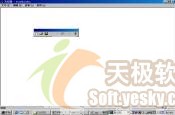在Visual C++自動生成的MFC框架應用程序中,當浮動工具條被拖離主框架窗口後,一般都會在工具條的右上角有一個"關閉"按鈕,應該說這個按鈕完全是按照Windows應用程序的用戶界面(UI)設計規范而設計的,也就是說所有的窗口都應該有一個地方讓用戶可以關閉這個窗口。但是有的開發人員偏偏提出來不想要這個"關閉"按鈕。本實例通過自定一個擴展的工具條類,實現了刪除工具條中"關閉"按鈕的目的。程序編譯運行後的界面效果如圖一所示:

圖一、沒有"關閉"按鈕的浮動工具條
一、實現方法
首先,針對刪除工具條上"關閉"按鈕的問題我們來確定一下實現的思路,因為我們要實現的功能與工具條有關,所以涉及的類肯定與 CToolBar有關。其次,為了判斷工具條浮動後"關閉"按鈕的狀態,我們需要一個表示狀態的成員變量;第三,實現工具條的浮動特性,需要對工具條窗口的ON_WM_WINDOWPOSCHANGED消息進行處理。這個消息負責CToolBar窗口大小、位置或Z坐標的變化,這裡為什麼不用WM_SIZE/OnSize來處理窗口大小的改變呢?因為僅當涉及窗口大小改變而不涉及窗口位置也改變時才這樣調用,所以當浮動工具條時不一定每次都調用處理WM_SIZE/OnSize。我們可以利用 基類CControlBar的m_pDockBar成員變量來調用GetParent()以獲取工具條的父窗口。從而改變父窗口的式樣--屏蔽系統菜單,來達到我們的目的--去掉"關閉"按鈕。
有了思路,下面來看看具體的實現代碼,我們先從CToolBar派生一個新類CToolBarEx,因為我們的目的是在浮動工具條時去掉"關閉"按鈕,所以僅僅判斷工具條是否浮動就可以了,這一點用CControlBar類的屬性判斷函數可以做到:BOOL IsFloating() const。在新類中添加一個成員變量,用它表示"關閉"按鈕的狀態:BOOL m_bMenuRemoved,當我們去掉主框架的系統菜單屬性時,它的值為TRUE。接著,我們用到了 m_pDockBar,用它來判斷父窗口類型是否是CMiniFrameWnd,該類代表了浮動工具條周圍的框架窗口。經過上述處理後,我們就可以放心地從CToolBar中去掉系統菜單了。下面是處理ON_WM_WINDOWPOSCHANGED消息的代碼:
void CToolBarEx::OnWindowPosChanged(WINDOWPOS FAR* lpwndpos)
{
CToolBar::OnWindowPosChanged(lpwndpos);
// should only be called once, when floated.
if( IsFloating() )
{
if( m_pDockBar && !m_bMenuRemoved )
{
CWnd* pParent = m_pDockBar->GetParent();
if( pParent->IsKindOf(RUNTIME_CLASS(CMiniFrameWnd)))
{
pParent->ModifyStyle( WS_SYSMENU, 0, 0 );
m_bMenuRemoved = TRUE;
}
}
}
else if( m_bMenuRemoved ) {
m_bMenuRemoved = FALSE;
}
}
二、編程步驟
1、 啟動Visual C++6.0,生成一個單文檔視圖結構的應用程序,將程序命名為"FltTBClsBtn";
2、 使用Class Wizard在項目中添加一個新類CtoolBarEx,其基類選擇為CToolBar;
3、 在CMainFrme類中將成員變量m_wndToolBar的類型修改為CtoolBarEx;
4、 添加代碼,編譯運行程序。
三、程序代碼
/////////////////////////////////////////////////////////////////////////////
// ToolBarEx.h : header file
#ifndef __TOOLBAREX_H__
#define __TOOLBAREX_H__
#if _MSC_VER >= 1000
#pragma once
#endif // _MSC_VER >= 1000
class CToolBarEx : public CToolBar
{
DECLARE_DYNAMIC(CToolBarEx)
// Construction
public:
CToolBarEx();
// Attributes
protected:
BOOL m_bMenuRemoved;
// Operations
public:
// Overrides
// ClassWizard generated virtual function overrides
//{{AFX_VIRTUAL(CToolBarEx)
//}}AFX_VIRTUAL
// Implementation
public:
virtual ~CToolBarEx();
// Generated message map functions
protected:
//{{AFX_MSG(CToolBarEx)
afx_msg void OnWindowPosChanged(WINDOWPOS FAR* lpwndpos);
//}}AFX_MSG
DECLARE_MESSAGE_MAP()
};
#endif // __TOOLBAREX_H__
//////////////////////////////////////////////////////////////////////// ToolBarEx.cpp : implementation file
#include "StdAfx.h"
#include "ToolBarEx.h"
#include <afxpriv.h>
#ifdef _DEBUG
#define new DEBUG_NEW
#undef THIS_FILE
static char THIS_FILE[] = __FILE__;
#endif
CToolBarEx::CToolBarEx()
{
// TODO: add construction code here.
m_bMenuRemoved = FALSE;
}
CToolBarEx::~CToolBarEx()
{
// TODO: add destruction code here.
}
IMPLEMENT_DYNAMIC(CToolBarEx, CToolBar)
BEGIN_MESSAGE_MAP(CToolBarEx, CToolBar)
//{{AFX_MSG_MAP(CToolBarEx)
ON_WM_WINDOWPOSCHANGED()
//}}AFX_MSG_MAP
END_MESSAGE_MAP()
// CToolBarEx message handlers
void CToolBarEx::OnWindowPosChanged(WINDOWPOS FAR* lpwndpos)
{
CToolBar::OnWindowPosChanged(lpwndpos);
// should only be called once, when floated.
if( IsFloating() )
{
if( m_pDockBar && !m_bMenuRemoved )
{
CWnd* pParent = m_pDockBar->GetParent();
if( pParent->IsKindOf(RUNTIME_CLASS(CMiniFrameWnd)))
{
pParent->ModifyStyle( WS_SYSMENU, 0, 0 );
m_bMenuRemoved = TRUE;
}
}
}
else if( m_bMenuRemoved ) {
m_bMenuRemoved = FALSE;
}
}
四、小結
本實例通過一個自定義類,處理Windows中窗口位置變化消息,實現了刪除浮動工具條上"關閉"按鈕的目的,在上述過程中,最主要的工作還是判斷當前窗口的父窗口是否為浮動工具條的框架窗口類-CMiniFrameWnd類。